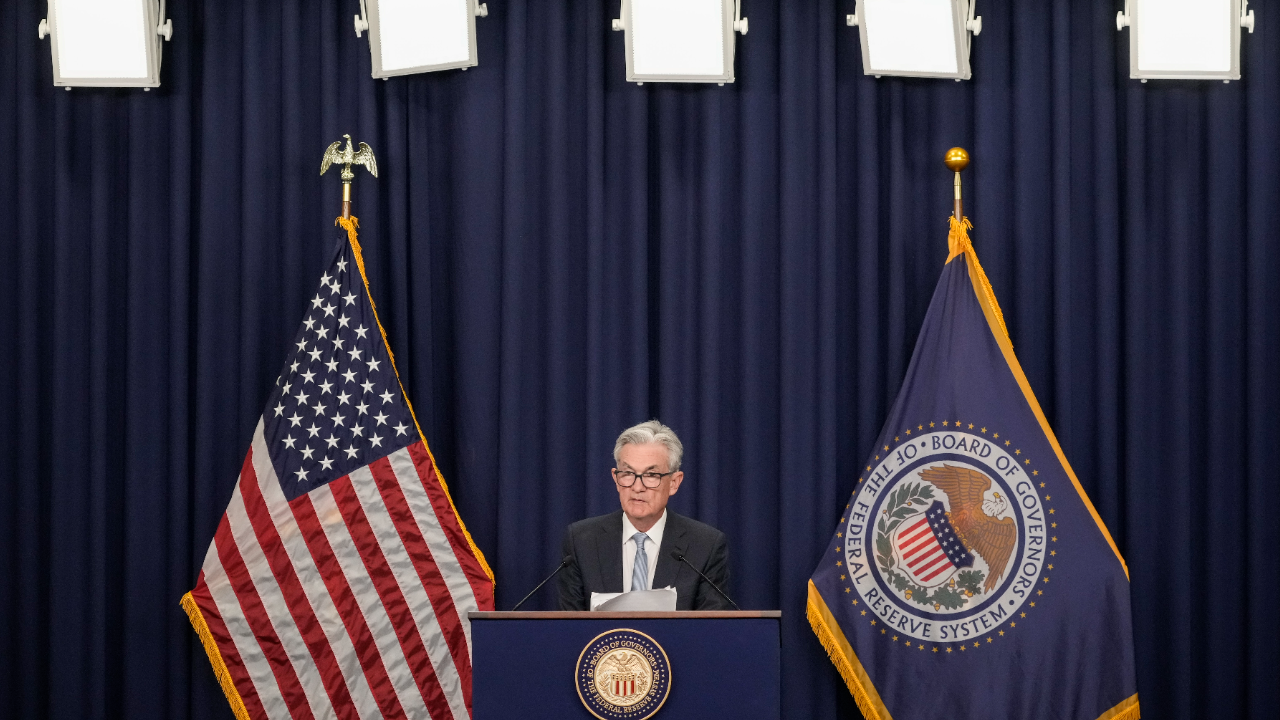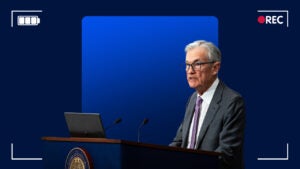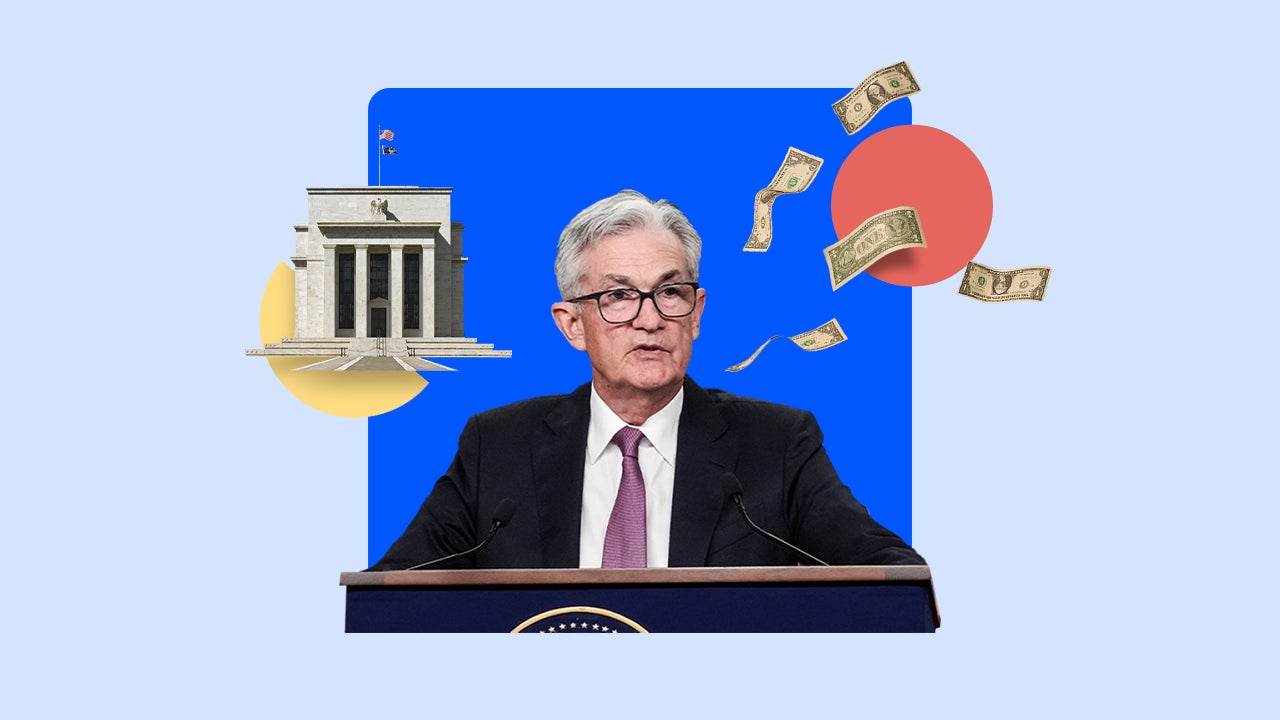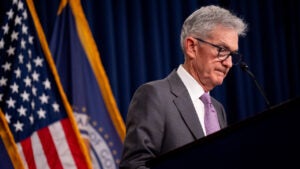Fed leaves interest rates unchanged, suggests it is not ready to begin cuts

The Federal Reserve left interest rates alone for the fourth consecutive meeting and acknowledged the progress it’s made at defeating red-hot inflation — but stopped short of indicating that rate cuts are around the corner as the economy’s strength continues to surprise.
The Federal Open Market Committee’s (FOMC) decision points to the likelihood that the Fed will not lift its key benchmark borrowing rate any higher than its current target range: 5.25-5.5 percent. That’s still, however, a level that hasn’t been seen since 2001, translating to significant gains on the prices consumers pay to borrow money. Mortgage rates, home equity lines of credit (HELOCs) and auto loans are the highest in more than a decade, Bankrate data shows.
An improving inflation picture is giving policymakers room to slow their fastest rate-hiking regime since the 1980s. The Fed officially targets a 2 percent annual rate, and prices rose 2.6 percent from a year ago as of December, according to their preferred gauge from the Department of Commerce. It marks a major improvement in a historically short period of time. Just last January, prices rose at a 5.5 percent annual rate, while inflation also peaked at 7.1 percent in June 2022.
The slowdown is also more pronounced than Fed officials expected. Last March, officials thought inflation would finish 2023 at a 3.3 percent annual rate, their projections show.
The FOMC “judges that the risks to achieving its employment and inflation goals are moving into better balance,” officials wrote in their post-meeting statement. “The committee does not expect it will be appropriate to reduce the target range until it has gained greater confidence that inflation is moving sustainably toward 2 percent.”
But officials aren’t yet ready to declare “mission accomplished” in their inflation fight. Defying theory, higher interest rates and slowing inflation haven’t slammed the brakes on economic growth. In the final two quarters of 2023, the U.S. economy expanded at the fastest pace since 2021. Unemployment has remained at a historically low level below 4 percent for the longest stretch of time since the 1960s, and job openings are still more plentiful than at any point before the pandemic.
It creates a difficult conundrum for U.S. central bankers, who are expected to soon start debating the proper timing for lowering interest rates. Officials don’t just attempt to keep prices stable but also aim to achieve maximum employment in the U.S. economy. Keeping interest rates too high for too long could risk damaging Americans’ job prospects — and the more inflation slows, the more restrictive their rate benchmark becomes.
But haunted by memories of the U.S. central bank pulling back too soon and reigning more inflation in the 1970s, Fed officials don’t want to risk giving the economy more juice that could make its war on inflation more pronounced and painful.
Officials aren’t appearing to be in any rush to cut interest rates. As of December, policymakers were expecting to cut interest rates three times this year. Investors, however, think the slowdown in inflation can pave the way for a much more aggressive series of rate cuts. Investors are currently pricing in six quarter-point, or 1.5 percentage points, worth of cuts for 2024, CME Group’s FedWatch tool shows.
The Fed has a more powerful influence over consumers’ wallets than any other policymaker in Washington. Just as the Fed’s rate acts as a lever on the key interest rates throughout Americans’ financial lives, it also influences how much consumers earn on their savings accounts and certificates of deposit (CDs). The highest yields in over a decade are also slowly starting to pull back, now that it looks like the Fed is done raising interest rates.
“Inflation has come down faster than anticipated, but whether or not this can be sustained is central to the Fed’s decision about when to begin cutting interest rates,” says Greg McBride, CFA, Bankrate chief financial analyst. “The Fed is certainly pushing back on the notion of a March interest rate cut, dashing investors’ hopes again, but keeping options open and remaining non-committal as a central bank does.”
The Fed’s rate decision: What it means for you
Savers
Even if the Fed cuts interest rates this year, the wins for savers aren’t yet over. Barring a major economic catastrophe, Fed officials are unlikely to reverse course and cut borrowing costs back to near-zero. Translation: Rates will stay higher for longer, meaning historic payouts on consumers’ savings accounts are bound to remain.
Don’t be surprised, however, if yields drift lower over the coming months. On many of the products Bankrate tracks, they already have. Last October, the top-yielding 5-year CD hit 4.85 percent annual percentage yield (APY). Today, it’s paying 4.6 percent. Even high-yield savings accounts — offering consumers an APY roughly nine times higher than the national average — have edged lower to 5.35 percent from 5.4 percent.
Consumers who can afford to tie up some of their cash — or retirees who want to add another no-risk, fixed-income investment to their portfolio — aren’t gaining any ground by waiting to lock in a CD. But if you’re primarily saving for emergencies, lower rates shouldn’t deter you from shopping around for an account with the best rate.
Keeping just $1,000 in a high-yield savings account offering 5 percent APY would give you $50 in interest. Stashing away $10,000, meanwhile, can earn a saver an extra $500 in a year.
Borrowers
If you don’t have an emergency fund, it’s an exceptionally costly era to have to turn to credit cards to fund an unexpected expense. Credit card rates have been hovering at the highest levels on record since September, most recently hitting 20.74 percent, Bankrate data shows. They could retreat when the Fed begins to cut interest rates but not enough to make high-cost debt less of a headache. Even when the Fed’s benchmark was at a record low, rates were holding above 16 percent annual percentage rate (APR).
The good news for credit card borrowers: The economy avoiding a recession means issuers are unlikely to pull back on the 0-percent introductory offers on balance transfer cards. If you’re looking to chip away at credit card debt, you can currently find a card that won’t charge you any interest for as long as 21 months, helping your debt repayments go even further. Be sure to calculate the fees associated with transferring that balance to a credit card and have a debt repayment game plan. A $10,000 balance with a 21-month no-interest offer would still require that consumers dedicate about $471 a month to eliminate that debt on time before their interest charges surge again.
Consumers with fixed-rate loans locked in before the Fed began raising interest rates have been protected from the Fed’s rapid rate hikes, but you can’t always time the market. If you’re going to have to finance a big ticket purchase in the near future, be sure to compare offers from multiple lenders before locking in a loan.
To set yourself up for lenders’ best offers, bolster your credit score by paying your bills on time and utilizing less than 30 percent of your available credit.
If you borrowed money after the Fed began raising interest rates and your credit score has improved, you might be able to refinance into a lower, fixed-rate loan.
Homebuyers
It’s not as affordable to finance a home as it was in the aftermath of the coronavirus pandemic, but it’s certainly getting cheaper than it was last fall. After surging above 8 percent in October for the first time since 2000, the 30-year fixed-rate mortgage has now fallen more than a percentage point, touching 6.93 percent as of Jan. 24, Bankrate data shows.
The difference might not seem like much, but for buyers simultaneously facing the dilemma of low inventory and high prices, the pullback creates more breathing room in homeowners’ budgets. The drop in mortgage rates since last fall translates to more than $4,000 in savings a year, Bankate’s mortgage calculator shows.
More improvement could be on the horizon. McBride predicts that the 30-year fixed-rate mortgage will fall to 5.75 percent by the end of the year, according to his 2024 interest rate forecast.
Central to housing affordability, however, are low inventory and high prices. Home prices in November snapped a nine-month streak of gains in S&P CoreLogic’s Case-Shiller Home Price Index, suggesting that home price appreciation might be losing some momentum. But housing is still more expensive than it was before the pandemic, with prices up 46 percent since February 2020, S&P CoreLogic’s data also shows.
The housing market has been especially troubling for first-time buyers. The typical age of a first-time buyer hit 35, near the oldest levels on record, according to National Association of Realtors data from November.
If you’re deciding to wait out a difficult market, you can still take steps that set you up for homeownership in the future. Work on growing your income, paying down your debts, bolstering your credit score and saving for a down payment, so you’re better prepared when the time does come.
Investors
No one is happier about the prospect of lower rates than investors. The S&P 500 and the Dow Jones Industrial Average have broken six fresh record highs so far in 2024.
But investors’ hopes can be dashed in an instant. The Fed looks unlikely to cut interest rates as aggressively as investors are expecting. Meanwhile, continued good news for the U.S. economy could quickly start to make markets jittery if it threatens the U.S. central bank’s plans to reduce borrowing costs.
The long-term investor, however, shouldn’t pay attention to those fears. Stay the course with your retirement savings, and keep a diversified portfolio. The temporary pain of high rates is meant to provide the long-term gain of slow and stable inflation — a positive for economic growth and company earnings in the long run.
Fed wants ‘greater evidence’ that its raised interest rates enough to cool inflation
In a pointed admission, Fed Chair Jerome Powell said discussions at the Fed’s latest rate-setting meeting lead him to believe that it’s unlikely the Fed will cut interest rates at its next meeting in March — though whether that proves reality “remains to be seen,” he said.
Officials aren’t so worried about inflation accelerating, though they’d be prepared to raise borrowing costs again if it did, Powell said. Rather, the greater risk is that inflation stays stuck in a holding pattern above 2 percent.
Between now and the March meeting, the Fed will have two more inflation and jobs reports from the Bureau of Labor Statistics, as well as another look at its preferred gauge from the Commerce Department.
“It’s not that we’re looking for better data, but a continuation of the good data we’ve been seeing,” Powell said at the post-meeting press conference, referring to what the Fed would need to see to feel confident enough about cutting rates. You’ve had six good months, very good months, but what’s really going to shake out here when we look back?”
Will the Fed still cut rates in 2024?
Rate cuts, however, haven’t been taken off the table. Powell said that “almost” all officials think slowing inflation will clear the path for them to cut borrowing costs sometime this year.
Investors are now starting to turn to the May or June meetings as the timing for the Fed’s first rate cut, CME Group’s data shows. A month ago, investors said the odds of rate cuts beginning in March were nearly 73 percent.
One takeaway that investors appreciated: Powell said the Fed doesn’t view a resilient economy as a problem, so long as inflation continues simultaneously cooling. Powell has previously indicated that officials believe they need to see “below-trend growth” to bring inflation down. His new comments suggest the Fed would still be willing to cut rates in a strong economy — different from previous cycles, when the Fed has aggressively slashed borrowing costs to save the economy from a recession.
Stocks soared to their highest of the trading day on the statement, though they quickly erased those gains once Powell took a March cut off the table.
“We want to see strong growth; we want to see a strong labor market,” Powell said. “We’re not looking for a weaker labor market. We’re looking for inflation to continue coming down, as it has been over the past six months.”
But the job isn’t over. Healing supply chains aren’t fueling disinflation as much as they once were — and the next mile of bringing inflation back down might rest within the labor market. A fresh look at companies’ compensation costs showed that wages rose 4.3 percent from a year ago in the fourth quarter of 2023, a major slowdown from the 5.7 percent rate in the second quarter of 2022 but more robust than at any point before the pandemic. The data signals that employers’ demands for workers are still outstripping supply, and elevated wage gains could put more pressure on the stickier side of inflation: services.
Helping to prevent the booming job market from contributing to more inflation last year, 2.8 million workers entered the labor force in 2023, Labor Department data shows. An aging population calls into question just how much longer those gains can last. A separate report from the Congressional Budget Office released on Jan. 18 showed that forecasters in Washington project the population will grow just 0.6 percent a year on average between 2024 and 2034.
The Fed has risks on both sides. Just as cutting rates too soon could spur more inflation, the Fed could also put its soft landing in jeopardy if it ends up leaving borrowing costs too high for too long.
“This is transitory disinflation,” says Brent Schutte, chief investment officer at Northwestern Mutual Wealth Management, harkening back to the phrase that Fed officials initially used to describe the post-pandemic price burst. “How do you land an economy that is as big as ours, at exactly the point where supply and demand meet? They always desire a soft landing. It’s just hard to achieve one.”
Why we ask for feedback Your feedback helps us improve our content and services. It takes less than a minute to complete.
Your responses are anonymous and will only be used for improving our website.






